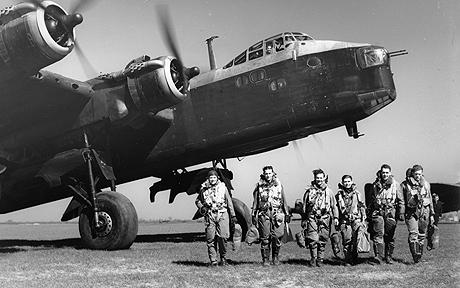The 7 Sqdn left from Oakington at 1943-07-28 at 21:55. Loc or duty Hamburg
He flew with a Short Stirling (type III, serial EF369, code MG-Z).
Campaign report of the USAAF:
27 July 1943 (Eighth Air Force): VIII Air Support Command Mission Number 5: 18 B-26B's are dispatched against Tricqueville Airfield, France; 17 hit the target at 1825 hours.
28 July 1943 (Eighth Air Force):
ANTISUBMARINE WARFARE
(AAF Antisubmarine Command): In the Bay of Biscay, German submarine, U-404, is sunk by a B-24 of the 4th Antisubmarine Squadron (Heavy) and a Royal Air Force (RAF) Libera- tor of No. 224 Squadron, at 45-53N 09-23W.
STRATEGIC OPERATIONS
(Eighth Air Force): VIII Bomber Command Mission Number 78: The aviation industry in Germany is targetted but bad weather hampers the raids. The targets are: 1. 182 B-17's are dispatched against the Fieseler Works at Kassel, Germany; 58 hit the target at 1027-1054 hours; they claim 27-15-22 Luftwaffe aircraft; 7 B-17's are lost, 4 are damaged beyond repair and 54 damaged; casualties are 15 WIA and 71 MIA. 2. 120 B-17's are dispatched to the Fw 190 plant at Oschersleben, Germany; 37 hit the target; they claim 56-19-41 Luftwaffe aircraft; 15 B- 17's are lost, 1 is damaged beyond repair and 64 damaged; casualties are 11 WIA and 134 MIA.
This is the deepest US bomber penetration into Germany to date. The raid achieves good results however, 22 B-17's are lost as fighters score first effective results with rockets. 105 P-47's, equipped with jettison- able belly tanks for the first time on a mission, escort the B-17's into Germany; other P-47's, going more than 30 miles (48 km) deeper into Germany than they have penetrated before, meet the returning bombers.
They surprise about 60 German fighters and destroy 9 of them; 1 P-47 is lost. VIII Air Support Command Mission Numbers 6 and 7: The primary targets are in Belgium and France, i.e.: 1. 18 B-26B's are dispatched against the coke ovens at Zeebrugge, Belgium; 17 hit the target at 1105 hours; 3 B-26's are damaged. 2. 18 B-26B's are dispatched against Tricqueville Airfield, France but the mission is recalled when the accompanying fighters do not join up.
Campaign report of the RAF:
27/28 July 1943
787 aircraft - 353 Lancasters, 244 Halifaxes, 116 Stirlings, 74 Wellingtons - returned to Hamburg. Brigadier-General Anderson, again flew in a Lancaster and watched this raid. The centre of the Pathfinder marking - all carried out by H2S on this night - was about 2 miles east of the planned aiming point in the centre of the city, but the marking was particularly well concentrated and the Main Force bombing 'crept back' only slightly.
This was the night of the firestorm, which started through an unusual and unexpected chain of events. The temperature was particularly high (30° centigrade at 6 o'clock in the evening) and the humidity was only 30 per cent, compared with an average of 40-50 per cent for this time of the year. There had been no rain for some time and everything was very dry .The concentrated bombing caused a large number of fires in the densely built-up working-class districts of Hammerbrook, Hamm and Borgfeld. Most of Hamburg's fire vehicles had been in the western parts of the city, damping down the fires still smouldering there from the raid of 3 nights earlier, and only a few units were able to pass through roads which were blocked by the rubble of buildings destroyed by high-explosive bombs early in this raid. About half-way through the raid, the fires in Hammerbrook started joining together and competing with each other for the oxygen in the surrounding air. Suddenly, the whole area became one big fire with air being drawn into it with the force of a storm. The bombing continued for another half hour, spreading the firestorm area gradually eastwards. It is estimated that 550-600 bomb loads fell into an area measuring only 2 miles by 1 mile. The firestorm raged for about 3 hours and only subsided when all burnable material was consumed. The burnt-out area was almost entirely residential. Approximately 16,000 multi-storeyed apartment buildings were destroyed. There were few survivors from the firestorm area and approximately 40,000 people died, most of them by carbon monoxide poisoning when all the air was drawn out of their basement shelters. In the period immediately following this raid, approximately 1,200,000 people - two thirds of Hamburg's population - fled the city in fear of further raids.
3 Mosquitos to Duisburg, 6 Wellingtons minelaying in the River Elbe, 11 OTU sorties. 1 Mosquito lost.
28/29 July 1943
4 Mosquitos to Hamburg and 3 to Düsseldorf, 17 aircraft minelaying in the Frisian Islands, 4 OTU sorties. No aircraft lost.
With thanks to the RAF and USAAF.net!
This record can also be found on the maps of Back to Normandy with Google coordinates. You can find the maps by clicking on this link on this location.
There are several possibilities to investigate the flight records on Back to Normandy. All the flights are plotted on maps, sorted "day by day", "by squadron", "by type aircraft", "by year or month", "by location" and much more! Don't miss this!!!
If you have any information that you want to share, please add your comment at the bottom of this record. Or send your information to [email protected]. This information will be added to the record.
Your photos and your information are very welcome! The young do care and with your help we keep up the good work.



